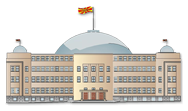Top Qs
Timeline
Chat
Perspective
Assembly of North Macedonia
Unicameral legislature of North Macedonia From Wikipedia, the free encyclopedia
Remove ads
The Assembly of the Republic of North Macedonia[f] is the unicameral legislature of North Macedonia. According to the Constitution, the Sobranie represents the people and is vested with legislative power. It can have between 120 and 140 MPs (currently 120), elected by proportional representation from 6 electoral districts, each contributing 20 MPs, and there are also 3 reserved seats elected from the Macedonian diaspora which are awarded only if the voter turnout was sufficient. MPs are elected for a term of four years and cannot be recalled during their term. The Sobranie is presided over by a President (Speaker). Its organization and functioning are regulated by the Constitution and Rules of Procedure. The Assembly's seat is in the Sobranie Palace in country's capital Skopje.
This article needs additional citations for verification. (February 2024) |
Remove ads
History
Summarize
Perspective
The first constitution of the country was adopted in November 1991, declaring it a parliamentary democracy. According to the constitution, the Assembly represents the citizens and has legislative power. The Assembly is the successor of the Assembly of the Socialist Republic of Macedonia, which was part of the Socialist Federal Republic of Yugoslavia.[1]
Оn 27 Аpril 2017, protestors stormed the Assembly in an attempt to prevent the election of a new president, the ethnic Albanian Talat Xhaferi, from the Democratic Union for Integration. Due to the inaction of the police, several MPs were injured.[2] In 2018, the MPs passed the Amnesty Law, which granted amnesty to some participants involved in the storming, who were not involved in violence or the organization of the storming.[3] Among those amnestied were MPs from the opposition who later voted in favor for changing the name of the country.[2]
During the COVID-19 pandemic in North Macedonia, In March 2020, an internal protocol for protection against COVID-19 was adopted, based on the recommendations of the Ministry of Health and the World Health Organization. It established a procedure for movement of employees and MPs, a schedule of disinfection of the premises, and placement of automated hand sanitizers. The president of the Assembly proposed the realization of the sessions online in December 2020, but this was not supported by the opposition. As a result, the Assembly had to continue its work in person, while also experiencing a block in its work for months due to the absence of a quorum.[1]
Remove ads
2024 election result
Remove ads
Presidents of the Assembly (1991–present)

- Parties
LPM (1) SDSM (3) DA (1) LDP VMRO–DPMNE (2) DUI (1) Alternativa (1)
- Status
Acting President
Notes
- VMRO-DPMNE (55)
- SPM (2)
- DPSM (1)
- Macedonian: Собрание на Република Северна Македонија, romanized: Sobranie na Republika Severna Makedonija, Albanian: Kuvendi i Republikës së Maqedonisë së Veriut
- Consists of VMRO-DPMNE, SPM, DPSM, DS, PODEM, ROM, Party of Vlachs from Macedonia, VOICE for Macedonia, NLP, SDU, DPR, RZPRM, OPER, Dignity, TMRO, MAAK, United for Macedonia and Macedonian Concept
- Consists of BDI, Alliance for Albanians (Sela's - led), PDSH, Democratic European Party, People's Movement, DPT, Movement of Turks for Justice and Democracy, Union of Roma in Macedonia and Bosniak Democratic Union
- Consists of Democratic Movement, Alternativa, Alliance for Albanians (Taravari's - led) the Besa Movement and others
Remove ads
See also
- Anti-fascist Assembly for the National Liberation of Macedonia
- Assembly of the Socialist Republic of Macedonia
External links
- Official website (in English, Macedonian, Albanian, and French)
References
Wikiwand - on
Seamless Wikipedia browsing. On steroids.
Remove ads










